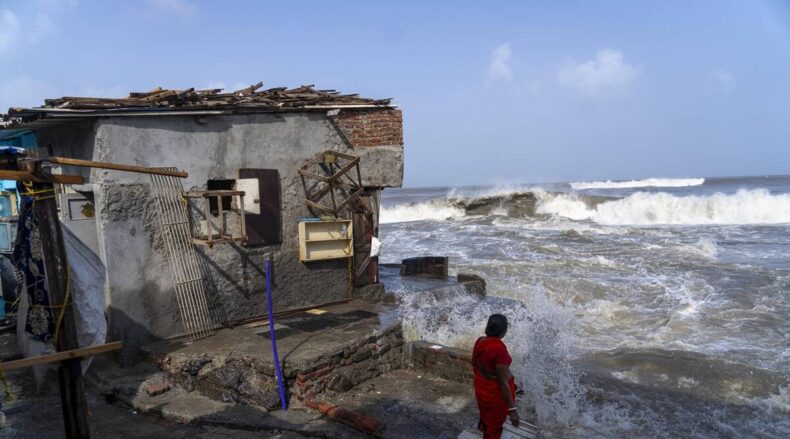Cyclone Biparjoy unleashed its wrath upon the Indian and Pakistani coasts, causing extensive damage and disruption on a fateful Friday. With houses losing their roofs, trees uprooted, and electric poles tumbling down, the region faced widespread power outages, leaving thousands without electricity.
As authorities braced themselves for the cyclone’s impact, over 180,000 people were evacuated from vulnerable areas in both India and Pakistan. While Gujarat, India’s western state, experienced tragic fatalities due to floodwaters, Pakistan, particularly Karachi, escaped major impacts but remained on high alert for potentially heavy rainfall.

The Impact of the Cyclone in Gujarat, India:
Gujarat, known for its vibrant culture and bustling cities, found itself in the path of destruction as Cyclone Biparjoy made landfall near the port town of Jakhau, close to the Pakistan border. The cyclone, initially classified as a severe cyclonic storm, had weakened to a cyclonic storm by Friday morning, as reported by the Indian Meteorological Department. Despite its downgrade, Biparjoy unleashed ferocious winds and relentless rainfall, leaving behind a trail of devastation.
Tragically, two lives were lost in Gujarat’s Bhavnagar district as two shepherds valiantly attempted to rescue their cattle from the raging floodwaters. They were swept away, succumbing to the force of nature. The cyclone’s impact became evident as roofs were torn off houses, trees were uprooted, and electric poles suffered damage, leading to widespread power outages across the region. In the hard-hit Kutch district of Gujarat, gale-force winds caused disruptions to the power supply, further exacerbating the challenges faced by the affected communities.
Promptly responding to the crisis, local authorities initiated rescue operations and carried out evacuation efforts ahead of the cyclone’s landfall. The aim was to minimize casualties and provide shelter to those in vulnerable areas. Amit Arora, a senior district official overseeing rescue operations, reported the immense challenges faced due to power disruptions and damage caused by strong winds.
Pakistan’s Precautionary Measures and Minimal Impact:
As the cyclone approached, Pakistan’s weather department issued advisories, urging local authorities to remain vigilant, particularly in coastal areas, due to the potential for heavy rainfall. Karachi, Pakistan’s sprawling metropolis, was put on high alert in anticipation of the cyclone’s impact. However, compared to the dire predictions, the cyclone’s effects in Pakistan remained relatively limited.
Some parts of Karachi experienced rainfall, but there were no reports of major damage or casualties. The city, which often grapples with infrastructure challenges during monsoon seasons, seemed to have escaped the worst of the cyclone’s fury. Nevertheless, authorities remained cautious and kept the region on high alert for moderate to heavy rainfall in areas such as Hyderabad, Nooriabad, and Thatta until Saturday.
The minimal impact in Pakistan can be attributed to the precautionary measures taken by the government and the responsiveness of local authorities. The timely warnings and preparedness allowed communities to brace themselves for potential disruptions and take necessary precautions.
Cyclone Biparjoy, though weakened upon landfall, proved to be a formidable force, leaving a trail of destruction and disruption along the Indian and Pakistani coasts. The severe winds, relentless rainfall, and resulting floodwaters caused extensive damage to infrastructure and homes. Thousands were left without electricity as roofs were torn off houses and electric poles succumbed to the force of the cyclone.
Gujarat, India’s western state, bore the brunt of the cyclone’s fury, resulting in tragic fatalities and significant damage. However, prompt evacuation efforts and rescue operations played a crucial role in minimizing the impact and loss of life. The affected regions will now require concerted efforts for recovery and rehabilitation.
Pakistan, while escaping major impacts, remained on high alert and demonstrated its readiness to respond to potential challenges posed by the cyclone. The precautionary measures and timely advisories ensured that communities were prepared for adverse weather conditions.
As the affected regions begin the process recovery government agencies, non-governmental organizations, and communities need to come together to provide relief and support to those affected by Cyclone Biparjoy. Restoring essential services, rebuilding infrastructure, and assisting the affected population will be critical in helping these communities rebuild their lives after this calamitous event.













